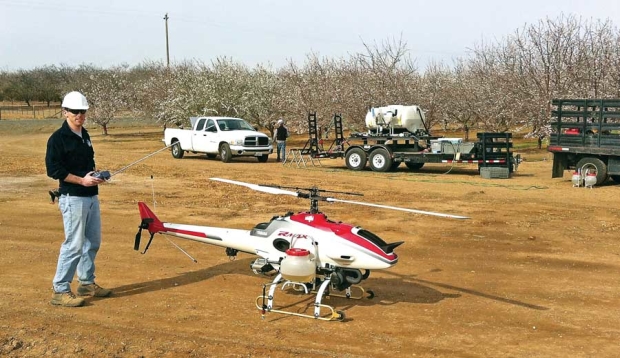
The RMAX unmanned helicopter must be operated within line of sight of the pilot, who uses a remote control using a 72 MHz transmitter. (Courtesy Yamaha)
Fruit growers and vineyard owners who have trees and vines on difficult terrain may soon have access to a new tool to treat them with fertilizers or chemical protection materials.
On May 6, the Federal Aviation Administration gave permission to the Yamaha Corporation of America to use its RMAX unmanned helicopter—a drone—in commercial applications in agriculture.
Steve Markofski, communications spokesperson for Yamaha, based in California, said the company would not likely sell the machines but would lease them, and he expected the lessees would be companies that provide services to growers and would have people trained in the operation of the robots.
The machine has been tested for three years in Napa Valley vineyards by researchers at the University of California, Davis. It is also being tested at Georgia Tech, Carnegie Mellon, University of California, Berkeley, and Virginia Tech.
The testing was to meet the requirements of the FAA, not to study feasibility. This technology—and the RMAX specifically—has been at work in Japan since 1997. There are 2,400 RMAX working in Japan and another 200 in other countries.
In Japan, the RMAX sprays pesticides and fertilizer on 2.4 million acres of rice each year—about 40 percent of that nation’s rice acreage—and other crops as well, Markofski said.
Rice is grown in fields saturated with water, where ground application is more difficult. And, Markofski said, the RMAX could easily spray grape vineyards on steep hillsides and could make timely applications of fungicides and growth regulators in orchards with difficult terrain or during times of excessive rainfall and soggy ground.
In Japan, he said, fields are often small and irregular in shape, so application work is often done by hand by workers on foot. Japan’s population is aging even more rapidly than is the U.S. population, so a dwindling number of people want to do such work.
While a pilot does not ride in the RMAX, it is not correct to say it is unpiloted. The RMAX is remotely piloted by a person on the ground, within line of sight of the helicopter and within a quarter mile, and the pilot moves the aircraft by remote control using a 72 MHz transmitter.
“What makes our machine unique is it is the first one weighing more than 55 pounds to receive permission from FAA,” Markofski said.
That means it is capable of performing heavier work than mere observation and monitoring using cameras, which some smaller unmanned aerial vehicles have won FAA approval to do.
The RMAX is described in detail on the company website, www.yamahaprecisionagriculture.com.
It is a small helicopter, with a single large rotor (about ten feet across) on top and a smaller rotor on the tail. It weighs 207 pounds and can carry a maximum payload of about 70 pounds, but the “practical payload” is listed at 35 pounds.
It is mounted with two tanks, each holding just over two gallons. A double-acting piston pump delivers material at a rate of 1.5 to 2-plus quarts per minute. For application of granular materials, two hoppers carry 18 pounds of material and discharge it by impeller at about 5 pounds a minute. Exact specs are given in metric units on the website.
It is powered by a two-cycle, 246 cc engine that runs on gasoline with oil added to the fuel. It will run for about an hour before it needs refueling, Markofski said.
According to Yamaha history, development began in 1983 when the company received a request to develop an unmanned helicopter for crop dusting from the Ministry of Agriculture, Forestry and Fishery of Japan. That began initial research and development efforts that led to the industrial-use unmanned helicopter R-50 in 1987.
In 1997, Yamaha released its new RMAX with greater payload capacity and greater ease of operation. Since then, RMAX helicopters have logged more than 2 million flight hours in agricultural uses include spraying of fungicides, insecticides, and herbicides, seeding, remote sensing, and frost mitigation. In Japan, RMAX helicopters are primarily used for seeding and spraying rice, but have also been used in wheat, soybeans, and vegetables.
Yamaha cites several advantages to using the RMAX: No soil compaction, no crop damage, reduced applicator exposure to chemicals, and less drift. A key advantage of the helicopter design is it requires no landing strip and can launch from anywhere.
The FAA set some specific limits on how the RMAX can be used. It must be in visual line of sight of the operator at all times, can’t exceed speeds of 45 miles per hours, can’t go above 400 feet altitude, must not leave the property on which it is operating, and can’t go within four miles of an airport.
The pilot must be trained and certified under FAA rules. It can’t be used in populated areas.
Yamaha has installed safety features including pre-takeoff diagnostics, altitude control, GPS (Global Positioning System) flight control, warning lights, rotor brakes, and safety default landing in case of loss of remote control. •






Leave A Comment